steering YAMAHA CYGNUS 125 2000 Owners Manual
[x] Cancel search | Manufacturer: YAMAHA, Model Year: 2000, Model line: CYGNUS 125, Model: YAMAHA CYGNUS 125 2000Pages: 76, PDF Size: 1.3 MB
Page 6 of 76
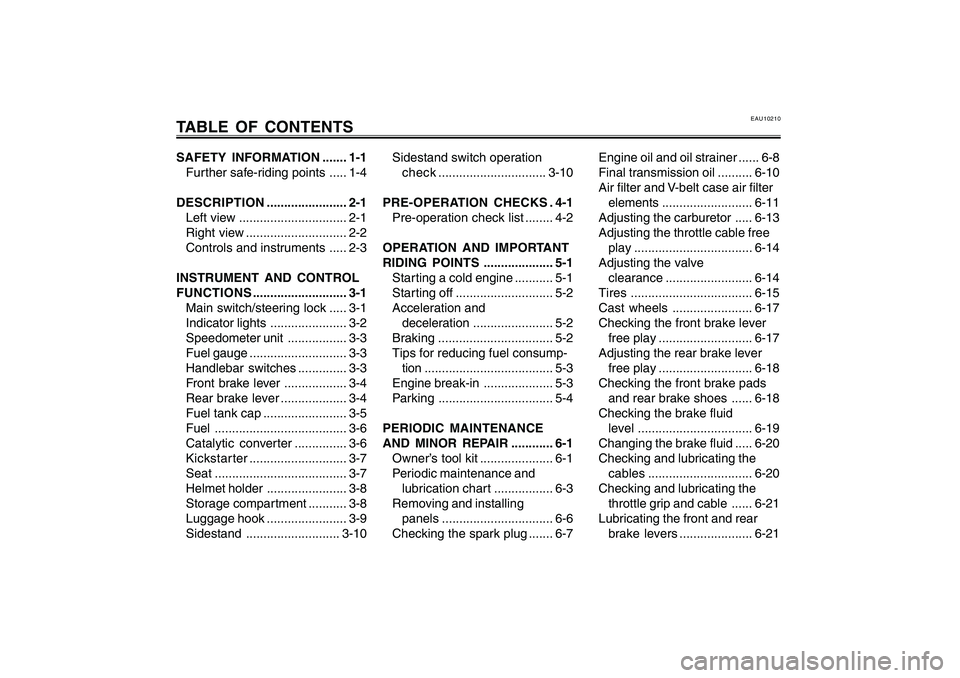
1
2
3
4
5
6
7
8
9
EAU10210
TABLE OF CONTENTSSAFETY INFORMATION....... 1-1
Further safe-riding points ..... 1-4
DESCRIPTION ....................... 2-1
Left view ............................... 2-1
Right view ............................. 2-2
Controls and instruments ..... 2-3
INSTRUMENT AND CONTROL
FUNCTIONS........................... 3-1
Main switch/steering lock ..... 3-1
Indicator lights ...................... 3-2
Speedometer unit................. 3-3
Fuel gauge ............................ 3-3
Handlebar switches .............. 3-3
Front brake lever .................. 3-4
Rear brake lever ................... 3-4
Fuel tank cap ........................ 3-5
Fuel...................................... 3-6
Catalytic converter ............... 3-6
Kickstarter............................ 3-7
Seat ......................................3-7
Helmet holder ....................... 3-8
Storage compartment ........... 3-8
Luggage hook ....................... 3-9
Sidestand ...........................3-10Sidestand switch operation
check...............................3-10
PRE-OPERATION CHECKS . 4-1
Pre-operation check list ........ 4-2
OPERATION AND IMPORTANT
RIDING POINTS.................... 5-1
Starting a cold engine ........... 5-1
Starting off ............................ 5-2
Acceleration and
deceleration....................... 5-2
Braking ................................. 5-2
Tips for reducing fuel consump-
tion..................................... 5-3
Engine break-in .................... 5-3
Parking ................................. 5-4
PERIODIC MAINTENANCE
AND MINOR REPAIR ............ 6-1
Owner’s tool kit ..................... 6-1
Periodic maintenance and
lubrication chart ................. 6-3
Removing and installing
panels ................................ 6-6
Checking the spark plug ....... 6-7Engine oil and oil strainer ...... 6-8
Final transmission oil..........6-10
Air filter and V-belt case air filter
elements..........................6-11
Adjusting the carburetor..... 6-13
Adjusting the throttle cable free
play ..................................6-14
Adjusting the valve
clearance.........................6-14
Tires...................................6-15
Cast wheels.......................6-17
Checking the front brake lever
free play...........................6-17
Adjusting the rear brake lever
free play...........................6-18
Checking the front brake pads
and rear brake shoes ......6-18
Checking the brake fluid
level .................................6-19
Changing the brake fluid .....6-20
Checking and lubricating the
cables..............................6-20
Checking and lubricating the
throttle grip and cable ......6-21
Lubricating the front and rear
brake levers.....................6-21
5ML-F8199-E0ch0.pmd2003/12/12, 16:02 5
Page 7 of 76
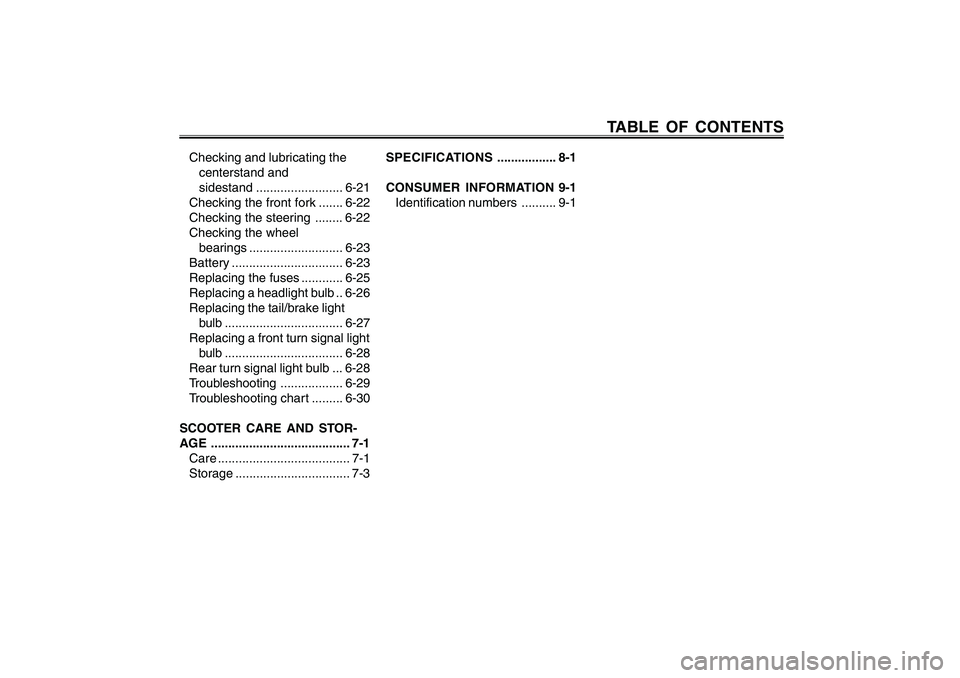
1
2
3
4
5
6
7
8
9
TABLE OF CONTENTS
Checking and lubricating the
centerstand and
sidestand.........................6-21
Checking the front fork .......6-22
Checking the steering........ 6-22
Checking the wheel
bearings ...........................6-23
Battery................................6-23
Replacing the fuses............6-25
Replacing a headlight bulb .. 6-26
Replacing the tail/brake light
bulb..................................6-27
Replacing a front turn signal light
bulb..................................6-28
Rear turn signal light bulb ... 6-28
Troubleshooting..................6-29
Troubleshooting chart .........6-30
SCOOTER CARE AND STOR-
AGE ........................................ 7-1
Care...................................... 7-1
Storage ................................. 7-3SPECIFICATIONS................. 8-1
CONSUMER INFORMATION 9-1
Identification numbers .......... 9-1
5ML-F8199-E0ch0.pmd2003/12/12, 16:02 6
Page 10 of 76
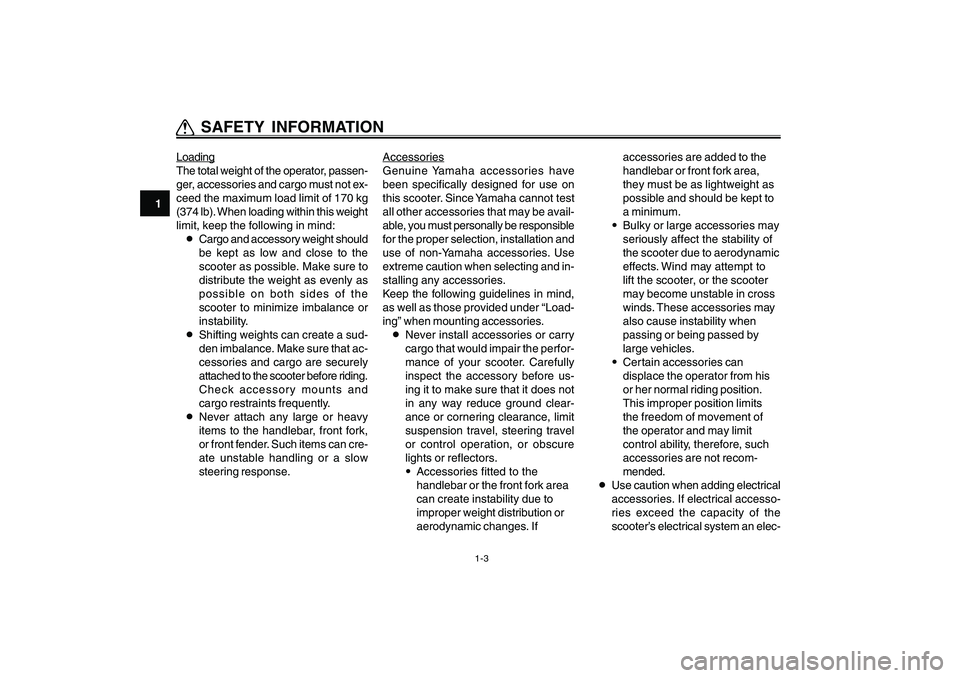
1-3
1
2
3
4
5
6
7
8
9
Q QQ Q
Q SAFETY INFORMATIONLoading
The total weight of the operator, passen-
ger, accessories and cargo must not ex-
ceed the maximum load limit of 170 kg
(374 lb). When loading within this weight
limit, keep the following in mind:
8Cargo and accessory weight should
be kept as low and close to the
scooter as possible. Make sure to
distribute the weight as evenly as
possible on both sides of the
scooter to minimize imbalance or
instability.
8Shifting weights can create a sud-
den imbalance. Make sure that ac-
cessories and cargo are securely
attached to the scooter before riding.
Check accessory mounts and
cargo restraints frequently.
8Never attach any large or heavy
items to the handlebar, front fork,
or front fender. Such items can cre-
ate unstable handling or a slow
steering response.
Accessories
Genuine Yamaha accessories have
been specifically designed for use on
this scooter. Since Yamaha cannot test
all other accessories that may be avail-
able, you must personally be responsible
for the proper selection, installation and
use of non-Yamaha accessories. Use
extreme caution when selecting and in-
stalling any accessories.
Keep the following guidelines in mind,
as well as those provided under “Load-
ing” when mounting accessories.
8Never install accessories or carry
cargo that would impair the perfor-
mance of your scooter. Carefully
inspect the accessory before us-
ing it to make sure that it does not
in any way reduce ground clear-
ance or cornering clearance, limit
suspension travel, steering travel
or control operation, or obscure
lights or reflectors.
9Accessories fitted to the
handlebar or the front fork area
can create instability due to
improper weight distribution or
aerodynamic changes. Ifaccessories are added to the
handlebar or front fork area,
they must be as lightweight as
possible and should be kept to
a minimum.
9Bulky or large accessories may
seriously affect the stability of
the scooter due to aerodynamic
effects. Wind may attempt to
lift the scooter, or the scooter
may become unstable in cross
winds. These accessories may
also cause instability when
passing or being passed by
large vehicles.
9Certain accessories can
displace the operator from his
or her normal riding position.
This improper position limits
the freedom of movement of
the operator and may limit
control ability, therefore, such
accessories are not recom-
mended.
8Use caution when adding electrical
accessories. If electrical accesso-
ries exceed the capacity of the
scooter’s electrical system an elec-
5ML-F8199-E0ch1re.pmd2003/12/12, 16:02 3
Page 17 of 76
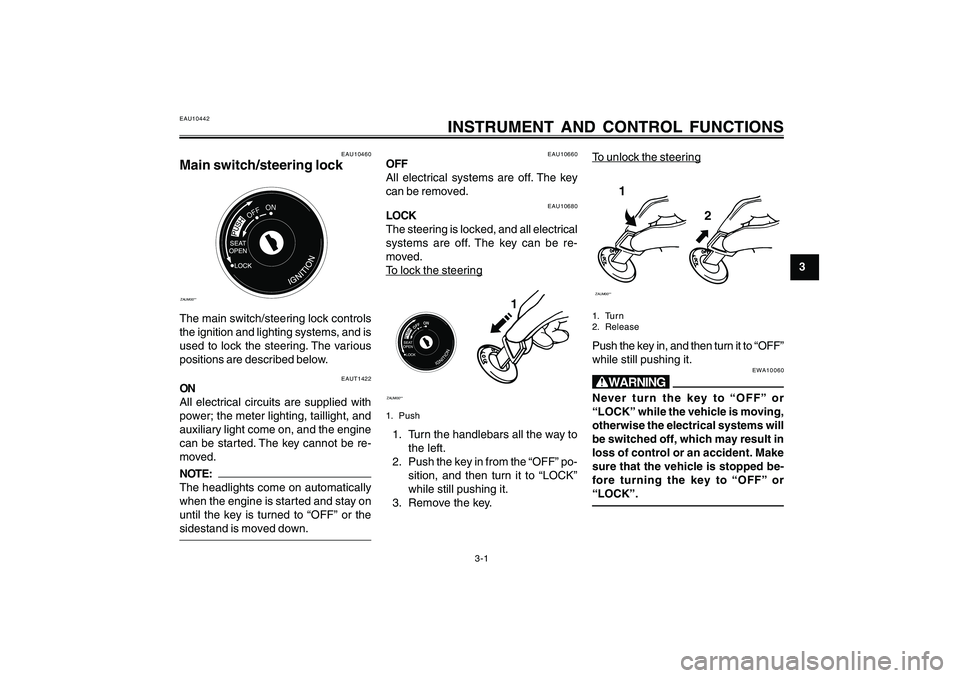
3-1
1
2
3
4
5
6
7
8
9
INSTRUMENT AND CONTROL FUNCTIONS
EAU10460
Main switch/steering lockZAUM00**
OFFON
The main switch/steering lock controls
the ignition and lighting systems, and is
used to lock the steering. The various
positions are described below.
EAU10660
OFF
All electrical systems are off. The key
can be removed.
EAU10442
INSTRUMENT AND CONTROL FUNCTIONS
EAUT1422
ON
All electrical circuits are supplied with
power; the meter lighting, taillight, and
auxiliary light come on, and the engine
can be started. The key cannot be re-
moved.NOTE:
The headlights come on automatically
when the engine is started and stay on
until the key is turned to “OFF” or the
sidestand is moved down.
EAU10680
LOCK
The steering is locked, and all electrical
systems are off. The key can be re-
moved.To loc
k the steer
ing
ZAUM00**
OFFON
1
1. Push1. Turn the handlebars all the way to
the left.
2. Push the key in from the “OFF” po-
sition, and then turn it to “LOCK”
while still pushing it.
3. Remove the key.
To unloc
k the steer
ing
1
2
ZAUM00**1. Tur n
2. ReleasePush the key in, and then turn it to “OFF”
while still pushing it.
EWA10060
wNever turn the key to “OFF” or
“LOCK” while the vehicle is moving,
otherwise the electrical systems will
be switched off, which may result in
loss of control or an accident. Make
sure that the vehicle is stopped be-
fore turning the key to “OFF” or
“LOCK”.
5ML-F8199-E0ch3re.pmd2003/12/12, 16:03 1
Page 38 of 76
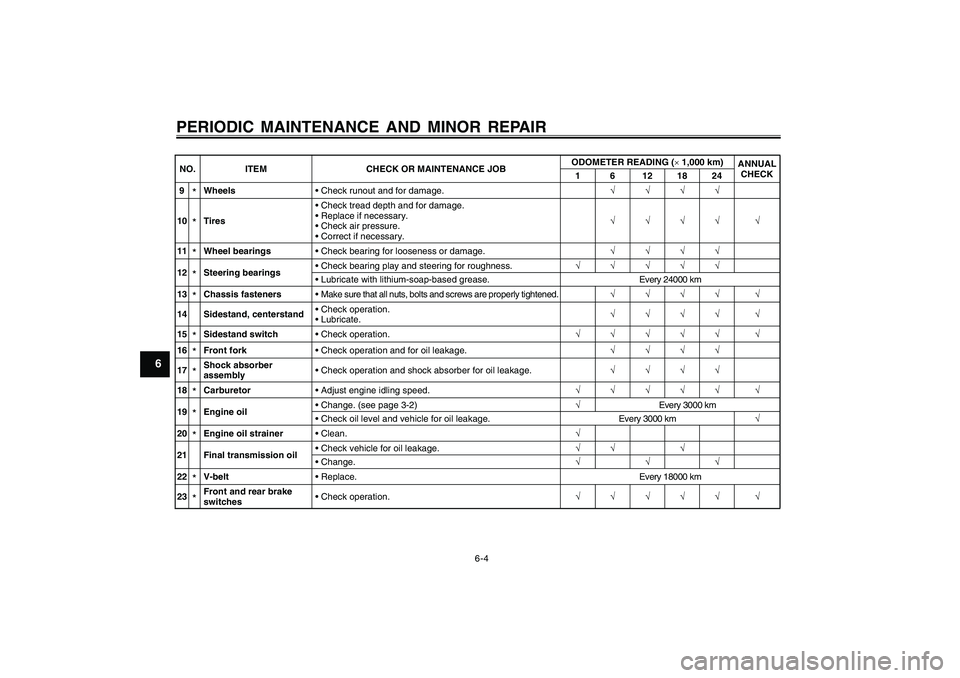
6-4
1
2
3
4
5
6
7
8
9
PERIODIC MAINTENANCE AND MINOR REPAIR9
*Wheels Check runout and for damage.�—�—�—�—
10*Tires Check tread depth and for damage.
Replace if necessary.
Check air pressure.
Correct if necessary.�—�—�—�— �—
11*Wheel bearings Check bearing for looseness or damage.�—�—�—�—
12*Steering bearings Check bearing play and steering for roughness.�—�—�—�—�—
Lubricate with lithium-soap-based grease. Every 24000 km
13*Chassis fasteners Make sure that all nuts, bolts and screws are properly tightened.�—�—�—�— �—
14 Sidestand, centerstand Check operation.
Lubricate.�—�—�—�— �—
15*Sidestand switch Check operation.�—�—�—�—�— �—
16*Front fork Check operation and for oil leakage.�—�—�—�—
17*Shock absorber
assembly Check operation and shock absorber for oil leakage.�—�—�—�—
18*Carburetor Adjust engine idling speed.�—�—�—�—�— �—
19*Engine oil Change. (see page 3-2)�—Every 3000 km
Check oil level and vehicle for oil leakage. Every 3000 km�—
20*Engine oil strainer Clean.�—
21 Final transmission oil Check vehicle for oil leakage.�—�— �—
Change.�—�—�—
22*V-belt Replace. Every 18000 km
23*Front and rear brake
switches Check operation.�—�—�—�—�— �— NO. ITEM CHECK OR MAINTENANCE JOBODOMETER READING (�u1,000 km)
ANNUAL
CHECK
1 6 12 18 24
5ML-F8199-E0ch6re.pmd2003/12/12, 16:04 4
Page 56 of 76
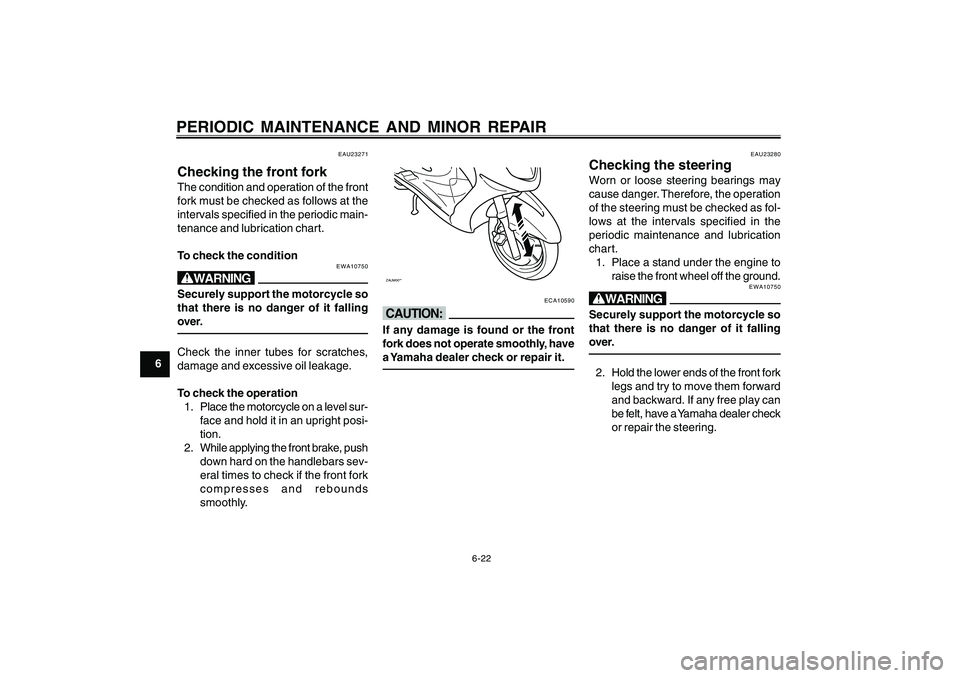
6-22
1
2
3
4
5
6
7
8
9
PERIODIC MAINTENANCE AND MINOR REPAIR
EAU23271
Checking the front forkThe condition and operation of the front
fork must be checked as follows at the
intervals specified in the periodic main-
tenance and lubrication chart.
To check the condition
EWA10750
wSecurely support the motorcycle so
that there is no danger of it falling
over.Check the inner tubes for scratches,
damage and excessive oil leakage.
To check the operation
1. Place the motorcycle on a level sur-
face and hold it in an upright posi-
tion.
2. While applying the front brake, push
down hard on the handlebars sev-
eral times to check if the front fork
compresses and rebounds
smoothly.
ZAUM00**
ECA10590
cCIf any damage is found or the front
fork does not operate smoothly, have
a Yamaha dealer check or repair it.
EAU23280
Checking the steeringWorn or loose steering bearings may
cause danger. Therefore, the operation
of the steering must be checked as fol-
lows at the intervals specified in the
periodic maintenance and lubrication
chart.
1. Place a stand under the engine to
raise the front wheel off the ground.
EWA10750
wSecurely support the motorcycle so
that there is no danger of it falling
over.2. Hold the lower ends of the front fork
legs and try to move them forward
and backward. If any free play can
be felt, have a Yamaha dealer check
or repair the steering.
5ML-F8199-E0ch6re.pmd2003/12/12, 16:04 22
Page 74 of 76

1
2
3
4
5
6
7
8
9
INDEXAAcceleration and deceleration.................. 5-2
Air filter and V-belt case air filter
elements................................................6-11BBattery.....................................................6-23
Brake fluid level, checking ......................6-19
Brake fluid, changing ..............................6-20
Brake lever, front ...................................... 3-4
Brake lever, rear....................................... 3-4
Brake levers, lubricating.........................6-21
Brake pads and shoes, checking..........6-18
Braking...................................................... 5-2CCables, checking and lubricating ...........6-20
Carburetor,adjusting...............................6-13
Catalytic converter................................... 3-6
Centerstand and sidestand, checking and lu-
bricating.................................................6-21DDimmer switch.......................................... 3-4EEngine break-in ......................................... 5-3
Engine oil and oil strainer .......................... 6-8FFinal transmission oil ..............................6-10
Front brake lever free play, checking....6-17
Fuel........................................................... 3-6
Fuel consumption, tips for reducing ......... 5-3
Fuel gauge ................................................ 3-3
Fuel tank cap ............................................ 3-5
Fuses, replacing.....................................6-25
HHandlebar switches.................................. 3-3
Headlight bulb, replacing........................6-26
Helmet holder............................................ 3-8
High beam indicator light .......................... 3-2
Horn switch............................................... 3-4IIdentification numbers.............................. 9-1
Indicator lights........................................... 3-2KKey identification number......................... 9-1
Kickstarter................................................ 3-7LLuggage hook........................................... 3-9MMain switch/steering lock......................... 3-1
Model label................................................ 9-2PPanels, removing and installing................ 6-6
Parking...................................................... 5-4
Part locations............................................ 2-1
Periodic maintenance and lubrication
chart ........................................................ 6-3
Pre-operation check list........................... 4-2
Rear brake lever free play, adjusting .....6-18SSafe-riding points...................................... 1-4
Safety information..................................... 1-1
Seat ........................................................... 3-7
Sidestand................................................3-10
Sidestand switch operation check .........3-10Spark plug, checking................................ 6-7
Specifications............................................ 8-1
Speedometer unit..................................... 3-3
Start switch............................................... 3-4
Starting a cold engine ............................... 5-1
Starting off ................................................. 5-2
Storage...................................................... 7-3
Storage compartment............................... 3-8
TTail/brake light bulb, replacing ................6-27
Throttle cable free play, adjusting..........6-14
Throttle grip and cable, checking and lubricat-
ing ..........................................................6-21
Tires........................................................6-15
Tool kit ....................................................... 6-1
Troubleshooting......................................6-29
Troubleshooting chart.............................6-30
Turn signal indicator light.......................... 3-2
Turn signal light bulb (front), replacing ...6-28
Turn signal switch ..................................... 3-4VValve clearance, adjusting ......................6-14
Vehicle identification number .................... 9-1WWheel bearings, checking ......................6-23
Wheels....................................................6-17
5ML-F8199-E0idx.pmd2003/12/12, 16:06 1